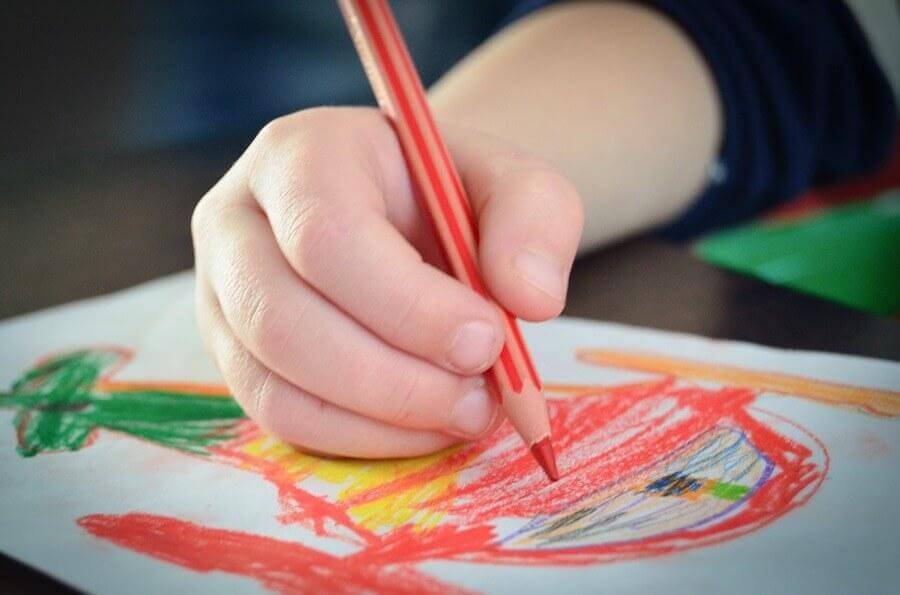How to Interpret Colors in Children's Drawings

Do you know how to interpret colors in children’s drawings? In this article, we’ll give you some clues to understanding your little ones’ behaviors and ideas.
The different branches of psychology have studied colors and emotions for a long time. People use certain colors based on their personal preferences, which are linked to emotions.
Set aside the concepts and traditional iconology of what certain colors represent for different cultures. We’ll focus on how different shades can reveal certain behaviors and predispositions.
In addition to shapes, the intensity of the strokes and the story behind the drawing itself can also indicate what children are thinking. Color choice also speaks clearly and strongly about kids’ emotional state.

Most common colors in children’s drawings
Although there are certainly more common colors because they’re in all boxes of crayons, children usually mix colors. In that sense, it’s good to know that mixing light colors show that kids are calm and connected to their emotions.
On the other hand, using more intense colors usually means active and energetic children with intense feelings, including aggressiveness.
Blue
This color is associated with calmness, well-being and relaxation. It’s usually the favorite of calm or timid children. In addition, it awakens the sense of creativity and sensitivity in kids.
Specialists estimate that children who use this color also develop self-control at younger ages. In addition, some children who use this color often have a condition called enuresis, a disorder that we also call “wetting the bed.”
Red
Red is a color that attracts kids’ attention because of its intensity. You can interpret its use in two different ways:
- If the child uses it often, he might be a hostile child with feelings of repressed anger.
- If the child uses it moderately, it can describe vitality and energy.
Black
Contrary to popular belief, it’s a color that isn’t always linked to negative or depressed feelings. It actually describes a child with good self-esteem and self-confidence.
Regarding using this color, you also need to look at the intensity of the strokes. If it’s very dark, it could also have other meanings.

Brown
This color represents responsibility. In that sense, when children choose it, they show that they’re diligent and prudent. However, using it excessively shows that they’re overwhelmed by daily activities.
Yellow
Yellow is synonymous with energy, dynamism, joy and sociability. It’s a color that shows happy children. In addition, you see all of the virtues associated with childhood. However, using it frequently in drawings shows problems with authority figures.
Green
Using this color too much can reveal laziness and a certain level of shyness and inhibition. On the other hand, there are also universal meanings for green: hope, tranquility, and a sense of harmony.
Purple
Using this color shows that the child feels melancholic, dissatisfied and restless for some reason. When used with yellow in drawings, it can mean that the child is overwhelmed by some type of pressure.
Finally, we want you to know that these analyses aren’t always correct when talking about interpreting or mixing colors in children’s drawings.
In any case, a psychoanalyst will be able to evaluate your child’s drawings to get a more accurate and conclusive diagnosis.
Do you know how to interpret colors in children’s drawings? In this article, we’ll give you some clues to understanding your little ones’ behaviors and ideas.
The different branches of psychology have studied colors and emotions for a long time. People use certain colors based on their personal preferences, which are linked to emotions.
Set aside the concepts and traditional iconology of what certain colors represent for different cultures. We’ll focus on how different shades can reveal certain behaviors and predispositions.
In addition to shapes, the intensity of the strokes and the story behind the drawing itself can also indicate what children are thinking. Color choice also speaks clearly and strongly about kids’ emotional state.

Most common colors in children’s drawings
Although there are certainly more common colors because they’re in all boxes of crayons, children usually mix colors. In that sense, it’s good to know that mixing light colors show that kids are calm and connected to their emotions.
On the other hand, using more intense colors usually means active and energetic children with intense feelings, including aggressiveness.
Blue
This color is associated with calmness, well-being and relaxation. It’s usually the favorite of calm or timid children. In addition, it awakens the sense of creativity and sensitivity in kids.
Specialists estimate that children who use this color also develop self-control at younger ages. In addition, some children who use this color often have a condition called enuresis, a disorder that we also call “wetting the bed.”
Red
Red is a color that attracts kids’ attention because of its intensity. You can interpret its use in two different ways:
- If the child uses it often, he might be a hostile child with feelings of repressed anger.
- If the child uses it moderately, it can describe vitality and energy.
Black
Contrary to popular belief, it’s a color that isn’t always linked to negative or depressed feelings. It actually describes a child with good self-esteem and self-confidence.
Regarding using this color, you also need to look at the intensity of the strokes. If it’s very dark, it could also have other meanings.

Brown
This color represents responsibility. In that sense, when children choose it, they show that they’re diligent and prudent. However, using it excessively shows that they’re overwhelmed by daily activities.
Yellow
Yellow is synonymous with energy, dynamism, joy and sociability. It’s a color that shows happy children. In addition, you see all of the virtues associated with childhood. However, using it frequently in drawings shows problems with authority figures.
Green
Using this color too much can reveal laziness and a certain level of shyness and inhibition. On the other hand, there are also universal meanings for green: hope, tranquility, and a sense of harmony.
Purple
Using this color shows that the child feels melancholic, dissatisfied and restless for some reason. When used with yellow in drawings, it can mean that the child is overwhelmed by some type of pressure.
Finally, we want you to know that these analyses aren’t always correct when talking about interpreting or mixing colors in children’s drawings.
In any case, a psychoanalyst will be able to evaluate your child’s drawings to get a more accurate and conclusive diagnosis.
All cited sources were thoroughly reviewed by our team to ensure their quality, reliability, currency, and validity. The bibliography of this article was considered reliable and of academic or scientific accuracy.
- Martínez-Cañellas, A. (1979). Psicología del color. Plástica/Dinámica. https://doi.org/10.1007/978-3-642-22371-6_14
- Sanz, C. (2013). Psicología del Color: El color y las emociones. Escola D’art i Superior de Disseny de Vic
- Santiago, J. (2007). El color de las emociones. Ciencia Cognitiva: Revista Electrónica de Divulgación.
- Berhard, N. (2006). Cómo interpretar los dibujos de los niños.
- Donzino, G. (2006). Interpretar dibujos. http://dspace.uces.edu.ar:8180/xmlui/handle/123456789/92
- Salsa, A. M., & Gariboldi, M. B. (2018). Experiencia con símbolos y comprensión de dibujos en niños pequeños de distintos contextos socioeconómicos. Avances en Psicología Latinoamericana, 36(1), 29-43. https://dialnet.unirioja.es/servlet/articulo?codigo=6231491
This text is provided for informational purposes only and does not replace consultation with a professional. If in doubt, consult your specialist.








